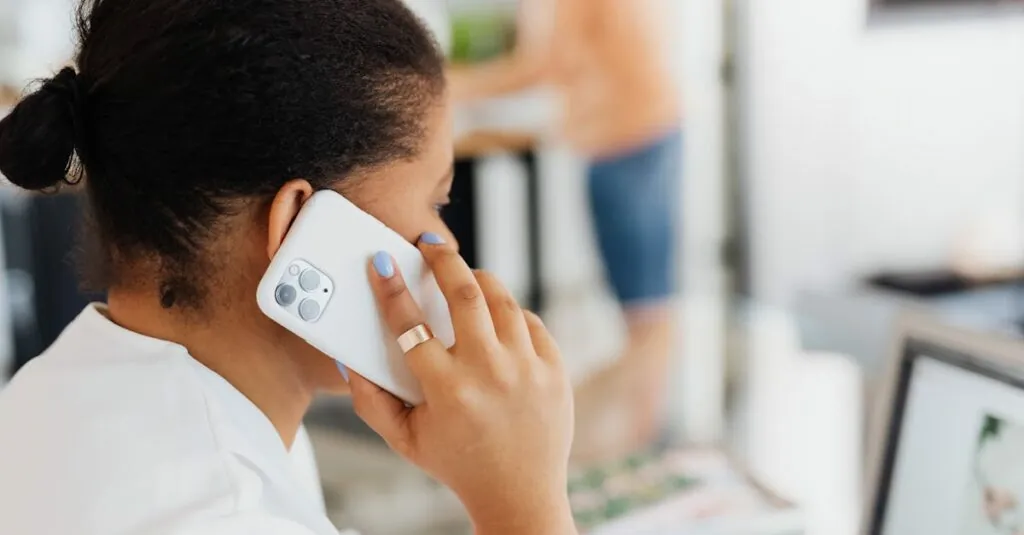Table of Contents
ToggleIn a world where privacy feels like a distant memory, many iPhone users wonder if their phone calls are secretly being recorded. Imagine chatting with a friend about your latest obsession with cat memes, only to find out that Apple’s been eavesdropping like a nosy neighbor. Yikes!
Understanding Call Recording on iPhones
Call recording on iPhones raises significant privacy concerns for users. Users often wonder about the legality and security of recording conversations.
The Legalities of Call Recording
Legislation regarding call recording varies by jurisdiction. Many states enforce the “one-party consent” law, allowing those on the call to record without notifying others. Other areas may require consent from all parties involved. It’s crucial for users to familiarize themselves with local laws before attempting any recording. Violations can lead to severe penalties or legal consequences. Apple’s policies prioritize user privacy, and they discourage any unauthorized recording.
Privacy Concerns
Privacy remains a primary issue for iPhone users. Users frequently express anxiety about unknown recording or eavesdropping. Apple implements strong security measures to safeguard user data. Despite this, the fear persists that malicious software on devices can compromise conversations. Users often seek reassurance regarding whether their calls remain confidential. Key features like end-to-end encryption further protect user communications, but vigilance is essential. Users should monitor app permissions carefully to prevent unauthorized access to their information.
Features of iPhone Call Recording
iPhone users often seek clarity on call recording functionalities. Understanding these features helps address privacy concerns.
Built-In Capabilities
Apple doesn’t offer native call recording functionality on iPhones. Users can’t record calls directly through the Phone app. However, the device includes features that enhance user privacy and security. End-to-end encryption protects conversations, ensuring that data remains confidential. Users can rely on these functionalities to maintain their privacy during calls.
Third-Party Applications
Certain third-party applications enable call recording on iPhones. These apps can vary in functionality and legality depending on the user’s location. App Store offerings include tools like Rev Call Recorder and TapeACall. Most of these applications require user consent before recording. Users must review local laws regarding consent to avoid potential legal issues. Investing time in researching these applications ensures users select a reliable option for their needs.
How to Record Calls on an iPhone
Recording phone calls on an iPhone isn’t straightforward due to Apple’s lack of native functionality. Users often seek alternative methods that align with their privacy needs and legal standards.
Step-by-Step Guide
- Choose a Third-Party App: Select a reliable call recording app, such as Rev Call Recorder or TapeACall. Ensure the app meets legal requirements for your location.
- Download the App: Install the chosen app from the App Store. Follow the prompts to set it up on your iPhone.
- Grant Permissions: Allow the app to access contacts and microphone. These permissions are crucial for proper functionality.
- Make a Call: Open the app and initiate a call through it. Some apps might require you to dial a recording number first.
- Start Recording: Tap the record button during the call to begin capturing audio. Monitor the app for any notifications or instructions.
Best Practices for Recording
Understand local laws governing call recording for compliance. One-party consent states permit recording if one party consents, while all-party consent states require everyone involved to agree. Inform the other party about the recording to maintain transparency. Choose the right environment for clarity; minimizing background noise enhances audio quality. Test recordings beforehand to ensure everything works well. Keep backups of recordings for future reference. Prioritize privacy by using secure apps with positive reviews. Avoid sharing sensitive information during calls, even if recorded.
Limitations and Drawbacks
Users face various limitations when considering call recording on iPhones. Third-party apps may not always offer consistent quality or reliability.
Quality of Recorded Calls
Recording quality can vary significantly between applications. Many users report varying levels of clarity and volume, impacting overall usability. Background noise often interferes with recordings, making it difficult to hear conversations. Some apps may compress audio files, reducing sound quality further. Users need to test multiple options to find a reliable solution that meets their expectations.
Storage and Accessibility
Storage options pose another challenge for iPhone users recording calls. Recorded files occupy significant storage space, influencing the device’s overall performance. Users must manage storage carefully to maintain phone functionality. Accessing recorded calls can also present difficulties; some apps store files within restricted folders. Finding recorded calls often requires navigating through specific app interfaces, which varies from app to app. Proper organization of recordings is crucial to ensure easy retrieval when needed.
Understanding the intricacies of call recording on iPhones is crucial for users concerned about their privacy. While Apple prioritizes user security and doesn’t provide native call recording features, third-party apps can facilitate this process. Users must remain aware of local laws regarding consent to avoid legal pitfalls.
Maintaining privacy is paramount in today’s digital landscape. By choosing reliable recording applications and being mindful of permissions, users can take control of their communications. Ultimately, it’s about balancing the desire to record important conversations with the need to protect personal information in an increasingly interconnected world.





